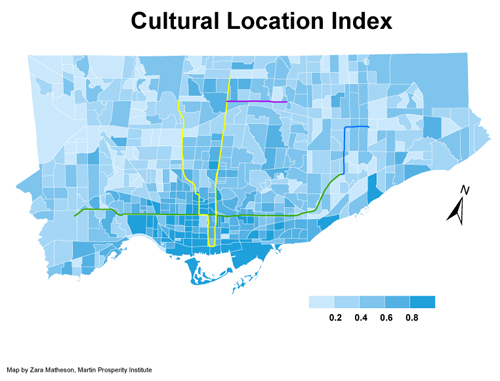A new report released last week by the City of Toronto entitled “From the Ground Up: Growing Toronto’s Cultural Sector,” examines the relationship between culture, economy and space in the city of Toronto. The report argues that a strong cultural sector has a variety of positive impacts on the and city’s competitiveness, prosperity and quality of place.
As one of the contributors to the report, The Martin Prosperity Institute developed a new metric for quantifying the cultural economy within a city. The Cultural Location Index (CLI) includes three major aspects of the cultural economy: the share of artists and cultural workers living in a census tract, the share of cultural workers working in a census tract and the number cultural facilities in that census tract. Because, when it comes to understanding cultural activity and geography, no single data source can give a full picture on its own, the CLI was developed to provide a quick overview of the concentration of the cultural activity in the City of Toronto, allowing areas that score well on all aspects to stand out. All data sources were weighted equally and the index was created using an equal-weight, inverse rank approach.
Cultural occupations include everything from dancers and photographers to archivists and journalists. These occupations were defined by Statistics Canada in the Canadian Framework for Culture Statistics (2004), and include 21 ‘Cultural Occupations’ and 27 ‘Cultural Support Occupations’. The 809 cultural facilities included in this analysis were provided by the City of Toronto cultural facilities database. They include places such as libraries, museums and performance spaces.
The development of the CLI is the end result of an intensive cultural mapping process that examined the location of culture across the city. Throughout this cultural mapping process it became clear that the residential and workplace patterns of the cultural workforce (especially those in creative & performance occupations) are indeed very different from those of the overall workforce in Toronto. The downtown core plays an important role for the cultural workforce with high concentrations of the cultural workforce living and working there. It is also the location of the majority of Toronto’s cultural facilities.
A score on the CLI can be anywhere between 0 and 1. A score of 0 would mean that there are no cultural workers who live or work in that census tract and no cultural facilities. Each census tract had at least some cultural activity within it. For example, the census tract that scores highest on the CLI (0.97) has 21% of its residents employed in cultural occupations along with 18% of its workforce. It is also home to 13 different cultural facilities. The lowest scoring census tract in Toronto has no cultural facilities or cultural workers and only about 1% of its residents are employed in cultural occupations elsewhere in the city. As expected, it is the primarily the downtown core that performs best on the Cultural Location Index as well as those census tracts that are better connected by public transit.
By developing this understanding of cultural locations and by looking at both larger and smaller geographic areas, “From the Ground Up” looks at the metro area, city, neighbourhoods, and even a specific building, two patterns were identified. First, cultural activity is both concentrated and distributed. A few locations exhibit high a concentration of cultural workers and facilities, but culture is still everywhere. Every location has at least some small thing. Second, the pattern is fractal. As you “zoom in” or “zoom out”, looking at either areas of high concentration or areas where little activity is found, the high concentration but distributed everywhere pattern is still seen.
The Cultural Location Index is a new tool that can be used by Planners and others interested in understanding and measuring the cultural activity within a city or neighbourhood. Without some kind of consistent measurement, the potential impact on a city’s cultural activity from rezoning and other strategic and planning decisions cannot be objectively evaluated or quantified. Cultural activity is well understood to enhance regional economic activity through tourism and other direct and indirect impacts on regional innovation and talent attraction. Often city growth and land-value enhancing activities, like converting old warehouses to condominiums, can negatively impact cultural activity and vitality. This is decried as “gentrification”, but it has proven difficult to objectively demonstrate the extent of the cultural activity that is at risk or to delineate the current boundaries of that activity. The CLI provides a way to address these concerns and level the playing field when considering trade-offs between increased land values and cultural vitality/economic prosperity.
For more insight into what makes up the cultural economy of Toronto and to see a detailed example of the Cultural Location Index:
The Martin Prosperity Institute at the University of Toronto’s Rotman School of Management is the world’s leading think-tank on the role of sub-national factors—location, place and city-regions—in global economic prosperity. We take an integrated view of prosperity, looking beyond economic measures to include the importance of quality of place and the development of people’s creative potential.
